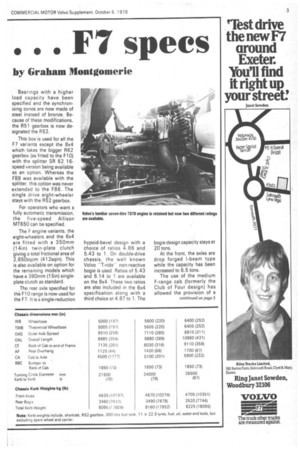• . F7 specs
Page 87

Page 89

If you've noticed an error in this article please click here to report it so we can fix it.
by Graham Montgomerie
Bearings with a higher load capacity have been specified and the synchronising cones are now made of steel instead of bronze. Because of these modifications, the R51 gearbox is now designated the R52.
This box is used for all the F7 variants except the 8x4 which takes the bigger R62 gearbox (as fitted to the F10) with the splitter SR 62 16speed version being available as an option. Whereas the F88 was available with the splitter, this option was never extended to the F86. The single drive eight-wheeler stays with the R52 gearbox.
For operators who want a fully automatic transmission, the five-speed Allison MT650 can be specified.
The F engine variants, the eight-wheelers and the 6x4 are fitted with a 350mm (14in) twin-plate clutch giving a total frictional area of 2,650sqcm (412sqin). This is also available on option for the remaining models which have a 380mm (15in) single' plate clutch as standard.
The rear axle specified for the F10 range is now used for the F7. It is a single-reduction
hypoid-bevel design with a choice of ratios 4.86 and 5.43 to 1. On double-drive chassis, the well known Volvo -T-ridenon-reactive bogie is used Ratios of 5.43 and 6.14 to 1 are available on the 8x4. These two ratios are also included in the 6x4 specification along with a third choice at 4.87 to 1. The
bogie design capacity stays at 20 tons.
At the front, the axles are drop forged I-beam type while the capacity has been increased to 6.5 tons.
The use of the medium F-range cab (formerly the Club of Four design) has allowed the provision of a
continued on page 5
sleeper version — something thre F86 lacked. This is available on the tractive unit with a 3.2m (10ft 6in) wheelbase while the 3.0m (9ft 10in) wheelbase model retains the short cab.
. No less than seven wheelbase variants are offered for the F7 4x2 rigids ranging from 3.6 to 6.0m (lift 10in to 19ft 8in) in 400mm (1 Sin) stages.
The choice of wheelbase for the eight-wheeler depends on whether single or double-drive is utilised. With the former, the choice is between 5.6 and 6.4m (18ft 4in and 21ft) while the choice for the 8x4 is the same with the addition of a short-wheelbase 5.0m (16ft Sin) model.
It is important to remember that the Volvo definition of wheelbase for an eight-wheeler is from the centre line of the front axle to the centre line of the leading rear axle and not the more common definition which specifies front axle to midbogie. A similar situation applies to the six-wheelers.
The "haulage" 6x2 F7 gives the operator a choice of three wheelbases at 4.0, 4.4 and 4.8m (13ft 1in, 14ft 5in and 15ft 9in). The "tipper" 6x4 version has an extra one at 3.6m (11ft 10in).
Parabolic leaf springs are offered throughout the range with the exception of the F7 eight-wheelers, both singleand double-drive, which uses parobolic springs at the rear and conventional multi-leaf springs at the front, For those vehicles fitted with parabolic springs an anti-roil bar is standard except where a double-drive bogie is fitted.
With weight saving in mind, an aluminium fuel tank of circular section is standard equipment on the tractive unit while a rectangular pressed-steel type is used on remainder of the range. The aluminium tank is of 345-litre (76ga1) capacity while the standard tank on the rigids is of 300 litres (66ga1) capacity with options of 200 and 400 litres (44 and 88ga1).
The braking system is full air with spring brakes for
parking while load-sensing valves are fitted on all singledrive units. The drum diameter is 413mrn (161/4in) at the front and 394mm ( 1 5 1/2 i n) at the rear for the tractive unit. For the rest of the range; the diameter alternates between one or the other dependent upon whether single or doubledrive is fitted.
The front brakes are 152mm (6in) across while at the rear 203mm (8in) wide drums are standard with the exception of the -UK spec" tractive unit, which utilises 178mm (7in) drums. Automatic slack adjusters are optional on all the F7 range.
Volvo has gone for armoured plastic piping on the F7 which is grouped together and run along the chassis in plastic conduits. The crossmembers have been designed accordingly.
Integral power assistance for the steering is now used for the F7 replacing the ram type of the old 86.
For the UK market Volvo has developed the F7 with no weight penalty over the 86. In TD 70 0 form with the 3.0in wheelbase, short cab and a 200-litre fuel tank, the F7 hasia kerb weight of 5.19 tonnes (5 tons 2cwt).
ISO standard spigotmounted 10-stud wheels are now fitted which are identical to the F10/ F12 wheels and can be used on UKmanufactured trailers. Tubeless 11x22.5 tyres are standard throughout with 10x20.0 tubed tyres available as an option.


























































































































































